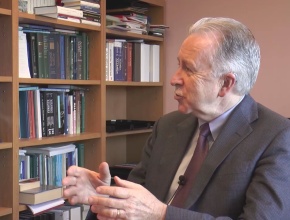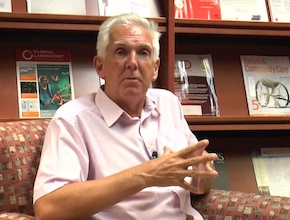References
Wedzicha JA, Banerji D, Chapman KR, et al; FLAME Investigators. Indacaterol-Glycopyrronium versus Salmeterol-Fluticasone for COPD. N Engl J Med. 2016 Jun 9;374(23):2222-34. doi: 10.1056/NEJMoa1516385. Epub 2016 May 15. PubMed PMID: 27181606.Roman Jaeschke: Good afternoon. Welcome to another edition of McMaster Perspective. Our guest today is Professor McIvor, the staff respirologist at St Joseph’s Hospital and an author of [the chapter on] chronic obstructive pulmonary disease in McMaster Textbook of Internal Medicine. The reason for us to meet today is a recent paper in the New England Journal of Medicine which compared use of different bronchodilators or inhaled corticosteroids (ICSs) in patients with chronic obstructive pulmonary disease (COPD). I have to admit the field is getting confusing. The number of different bronchodilators, puffers [inhalers], preparations is difficult to grasp. Could you take us through your pattern of use of those medications in COPD?
Andrew McIvor: Thank you for joining us today to talk about COPD. There is a lot of new medications that have come to the market and it can be somewhat confusing, but I think we really need to move back and think about COPD. In office-based practice, particularly in patients that have been smokers, you should consider doing some spirometry. Patients with COPD have persistence of airflow obstruction defined as a forced expiratory volume in 1 second (FEV1) to forced vital capacity (FVC) ratio of less than 70% along with impairment, ie, a low number of their FEV1. In these patients, the most important thing – in fact even more important than perhaps doing a spirometry – is to advise them, if they are smokers, to stop smoking.
Then again, we need to encourage people to be a little bit more active in their lifestyle. Most of us, as we grow older, become a little bit deconditioned: we do not do as much exercise and then if we do something, we become short of breath or have some symptoms. Once we have tried to encourage some exercise, if patients are limited by shortness of breath, the crucial factor in COPD is to optimally bronchodilate them. If you look at the national and international guidelines, we have usually, particularly in Canada – more so than the Global Initiative for Chronic Obstructive Lung Disease (GOLD) guidelines – we have been very anticholinergic-friendly.
In general, I would still say to a physician that when you first consider the diagnosis, start a patient on a long-acting anticholinergic preparation, internationally known as long-acting muscarinic antagonist (LAMA) treatments. I do think you should send all of those patients for spirometry; if they come back with their spirometry results and are still symptomatic on initial treatment with a long-acting anticholinergic or have moderate or severe impairment of their FEV1, they should be started on foundation treatment with a long-acting ß2-agonist (LABA)/LAMA combination medication. I think using these medications will optimally or maximally bronchodilate the patients and allow them to break that vicious downward spiral of symptoms, deconditioning, and limited exercise.
I do still think there are lots of other alternatives for individuals. There is, however, a little bit of a pushback from what we would call triple therapy, the prescription of a LAMA plus an ICS/LABA combination therapy for quite a few patients. The reason for this is getting back to the definition: COPD is sometimes defined as a non-steroid-responsive obstructive lung disease, whereas asthma is a steroid-responsive obstructive lung disease. I know it can be a little bit confusing because of the new condition ACOS, asthma-COPD overlap syndrome, which is perhaps what we are identifying in some of those severe patients.
RJ: I think you elaborated a bit on already on the place of ICSs. Whenever we admit people with COPD to a hospital, we actually put them on high doses of steroids, and we are substituting [them later] then by high doses of inhaled corticosteroids. How could we define it slightly closer or more precise: who needs this class?
AM: That is a very interesting question. My colleague, Professor [Parameswaran] Nair from McMaster University will tell us all that we can look at people’s sputum and tell what their eosinophil count is, know whether they have asthma or COPD, and how much or if they need inhaled steroids at all. But most of us in day-to-day practice cannot do that.
There is some evidence that actually shows that in chronic inflammation in COPD it is the neutrophil that we can find in the lungs, but even people that have a predominant neutrophilic inflammation in a somewhat stable state actually have increasing eosinophils due to the inflammation plus or minus infection that occurs in exacerbation, which is the reason why we still will use a short course of oral steroids during an acute exacerbation.The dilemma is: do patients with common-or-garden COPD really need an inhaled steroid? Just to remind you, if we think back to our asthmatic patients, over the last 20 or 30 years that we now are aggressively using inhaled steroids or ICS/LABA combination therapy in asthma, asthma morbidity, mortality, and hospitalizations have dramatically decreased. However, currently we are still using a lot of triple therapy or ICS/LABA in COPD and in spite of that our hospitalizations are increasing. Perhaps we do need to use alternative treatments to try and help our patients benefit.
 English
English
 Español
Español
 українська
українська






